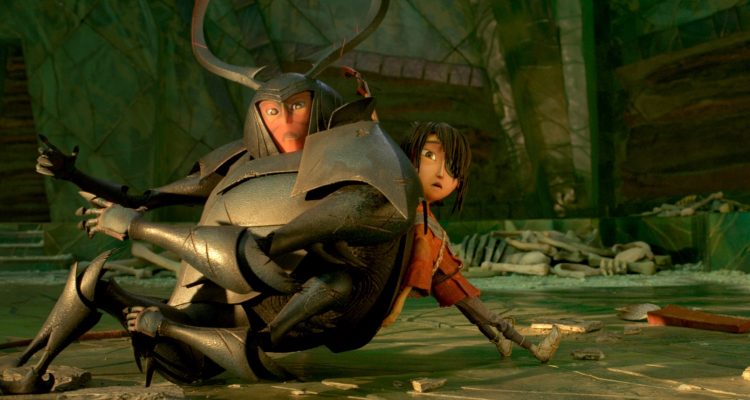“If you must blink, do it now. Pay careful attention to everything you see, no matter how unusual it may seem. If you look away, even for an instant, then our hero will surely perish.”
That narration opens Laika’s latest stop-motion marvel, and you won’t struggle to heed its warnings with a film this beautifully and lovingly crafted. A fable set in feudal Japan, “Kubo and the Two Strings” is as much about the magic of storytelling as it is about a boy growing up as he embarks on an epic quest. The theme of the power of narrative carries throughout the film, with a conclusion that is somehow both simple and surprisingly complex for a children’s movie.
 As the son of a famous samurai and a goddess, Kubo (Art Parkinson) is developing powers of his own. He mostly uses them to entrance the nearby townspeople with his stories and origami that comes to life with the help of his shamisen, a magical two-stringed instrument. He and his ill mother spend their lives in a cave away from the village, and she warns him against going out at night. His grandfather (Ralph Fiennes) stole his left eye shortly after he was born, and he now wants the other one. When he stays out after dark, his actions bring him to the attention of evil spirits, and he is forced to flee to the Far Lands. Joined by Monkey (Charlize Theron) and Beetle (Matthew McConaughey), he embarks on a quest to find armor that will keep him safe from his grandfather and the spirits.
As the son of a famous samurai and a goddess, Kubo (Art Parkinson) is developing powers of his own. He mostly uses them to entrance the nearby townspeople with his stories and origami that comes to life with the help of his shamisen, a magical two-stringed instrument. He and his ill mother spend their lives in a cave away from the village, and she warns him against going out at night. His grandfather (Ralph Fiennes) stole his left eye shortly after he was born, and he now wants the other one. When he stays out after dark, his actions bring him to the attention of evil spirits, and he is forced to flee to the Far Lands. Joined by Monkey (Charlize Theron) and Beetle (Matthew McConaughey), he embarks on a quest to find armor that will keep him safe from his grandfather and the spirits.
This description cannot nearly capture the wonder and weirdness of the world created by Laika’s team. President and CEO Travis Knight takes on directorial duties for this first time, and it’s as assured a debut as one could hope for. He has been credited as Lead Animator on all of Laika’s previous features – ”Coraline,” “ParaNorman” and “The Box Trolls” – so it’s a natural leap that makes for the studio’s most ambitious film to date. Part of the joy of watching Laika’s stop-motion animation is the attention to detail, whether it’s the nubby texture of a blanket or Kubo’s tiger’s eye-like iris. Kubo’s origami deserves a special shout-out for both its construction as well as the imaginative way that it is employed throughout the story. But as much as “Kubo and the Two Strings” shines in the small things, it doesn’t have trouble going big. The film’s most awe-inspiring scene finds Kubo, Monkey and Beetle battling a massive skeleton, and it’s an achievement in animation and sheer creativity. Stay for the requisite Laika post-credits scene that sheds light on how this scene was made, but finding out how they pulled it off doesn’t take away from its impact.

The animation studio is known for combining wild creativity and darkness in their children’s films, venturing far deeper than Disney tends to go into the realm of melancholy. But they balance that sadness and peril with deft humor and visuals so impressive that you almost forget that what you’re watching is terrifying and heartbreaking at times. That said, some of the story, characters or even just the concept that Kubo’s grandfather stole his eye (!) may prove too much for the youngest viewers. Others will love a story that doesn’t hesitate to scare them a little bit – or a lot- when it comes to the nightmarish, doll-like spirits voiced by Rooney Mara.
It’s odd that in a film set in fantasy Japan, the major roles are all played by white actors. George Takei gets billing, but he only gets a handful of lines (including an “Oh my,” where you can almost hear the wink in his voice). The cast largely does an excellent job – with special praise due to Brenda Vaccaro for her turn as an elderly village woman – but the goodwill earned by making a film with Japanese characters is called into question by making this choice. Laika is a small company playing with the giants of Pixar, Disney and Illumination Entertainment, and the thinking may be that using A-list actors will bring them additional notice, but it’s still disappointing. Though Theron hasn’t done much voice work to date, she’s perfect here, at once imbuing Monkey with strength and a dry wit. Her devotion to Kubo is reaffirmed through practically every word. In his first animated role, McConaughey rightly sheds his trademark Texas accent, and he brings humor and charm to Beetle, though it’s more of a one-note performance than suits the character.

“Kubo and the Two Strings” feels like a miracle, evoking joy, surprise and wonder in its audience. As much as the children at my screening were giggling, the adults seemed as much in the film’s thrall as the younger viewers, demonstrating the real power of a story well told. [A-]

